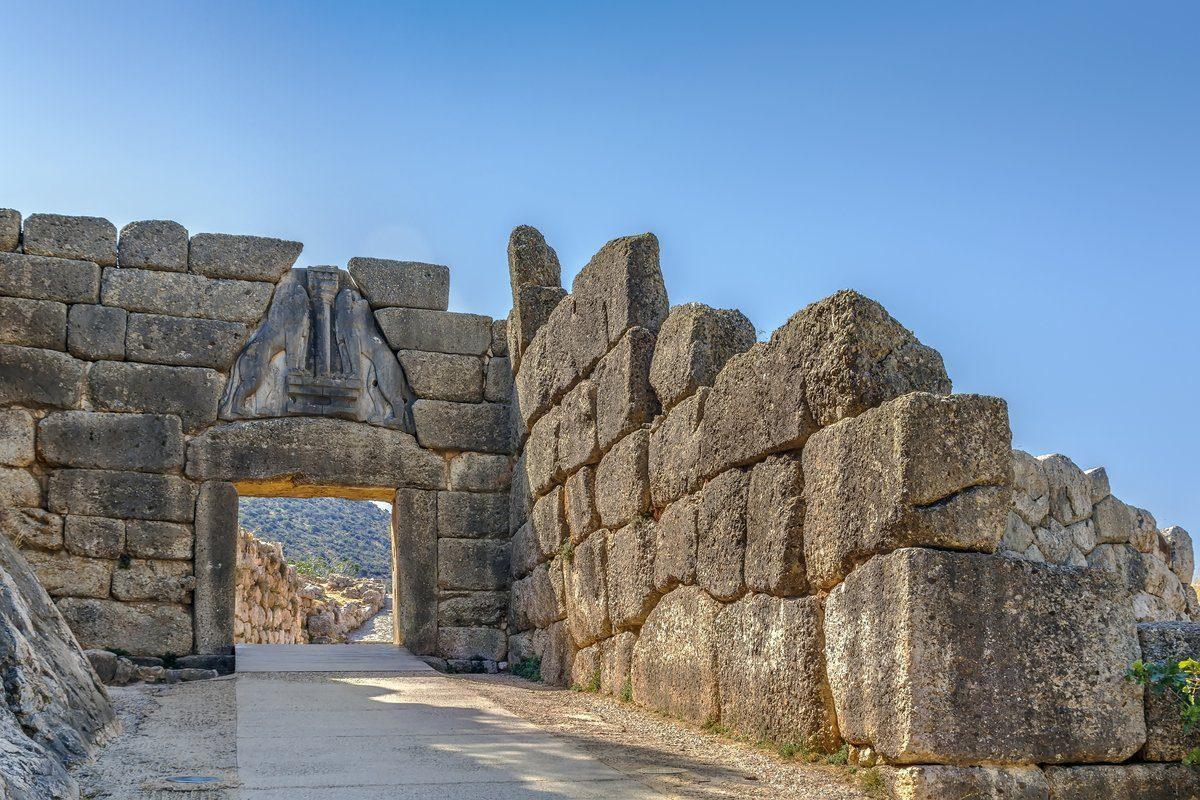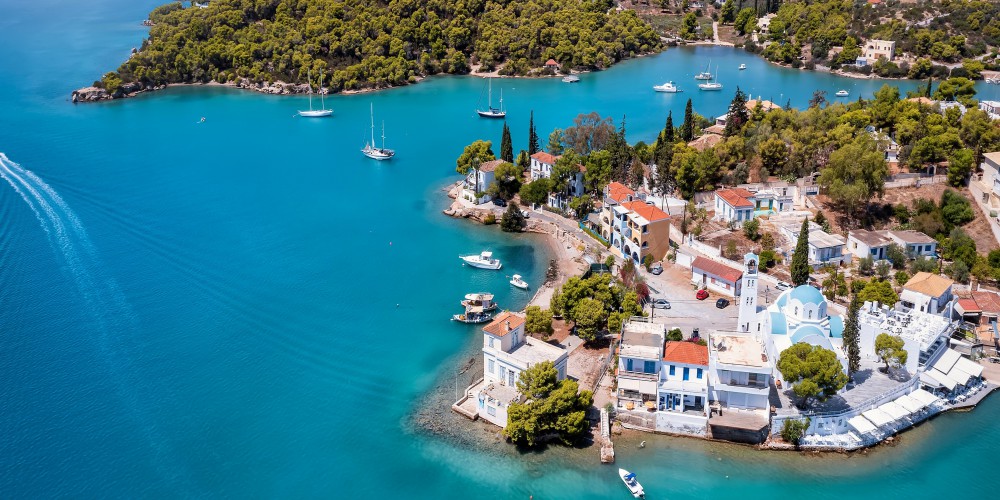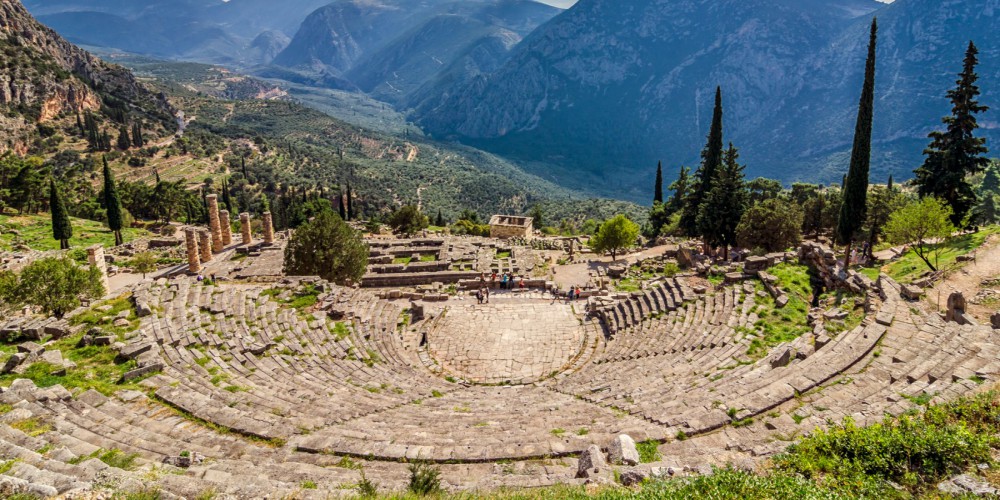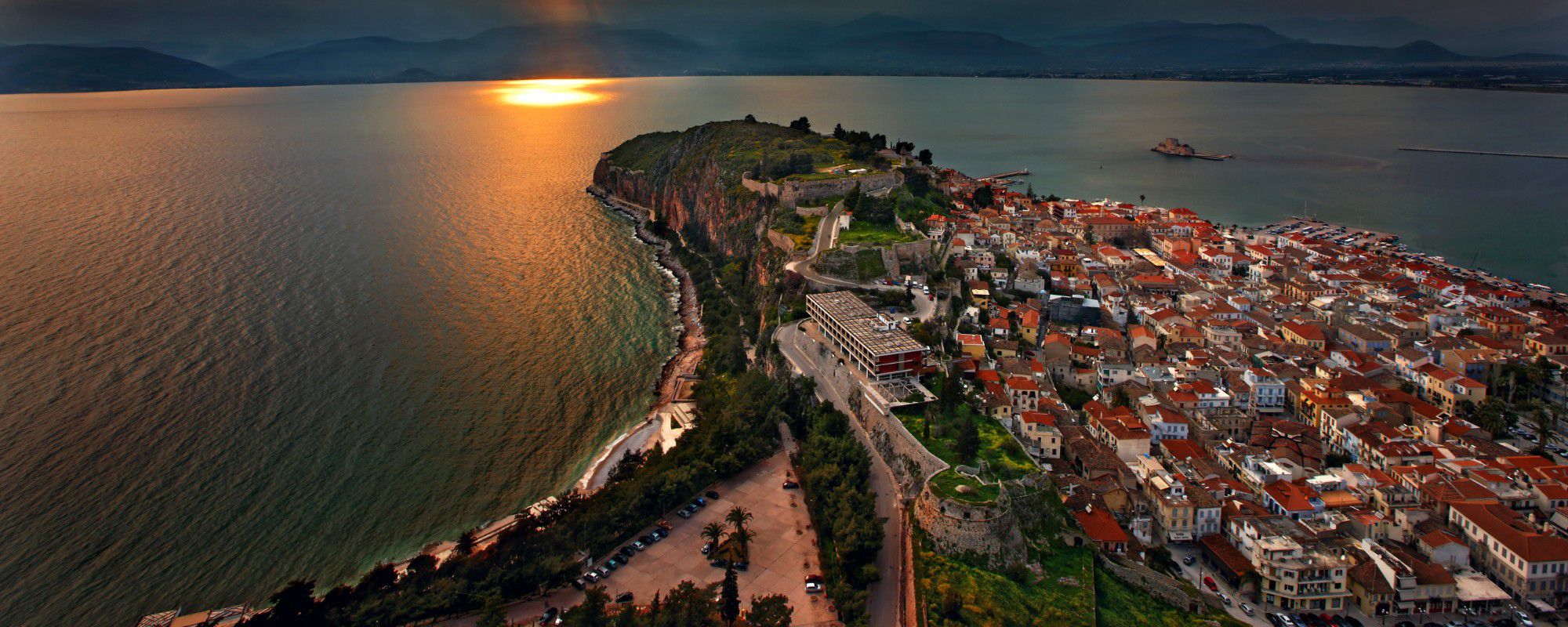
Nafplio Travel Guide (2026 Update)
Key Takeaways
- Nafplion is the first capital of the modern Greek state and one of the most historical and romantic cities in Greece.
- It is located in the northeastern part of the Peloponnese, about 2 hours away from downtown Athens.
- Nafplion offers a combination of history, idyllic beaches, and a picturesque environment.
- Key attractions in Nafplion include the Bourtzi castle, sailing tours along the coast, the Archaeological Museum, the Arvanitia Promenade, Palamidi Castle, traditional cuisine, day trips to surrounding regions, and beautiful beaches.
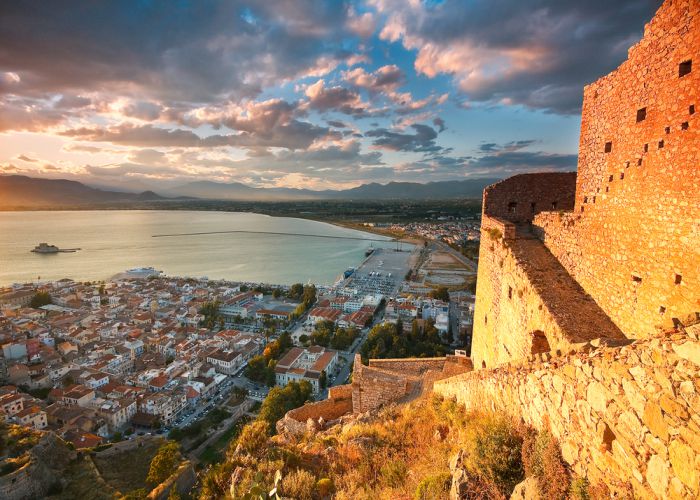 Nafplion view from above - credits: Milan Gonda/Shutterstock.com
Nafplion view from above - credits: Milan Gonda/Shutterstock.com
It's time to follow us on a trip to Nafplion, the first capital of the modern Greek state and one of the most historic and romantic cities in Greece.
Our ultimate Nafplion Travel Guide will introduce you to the history of the city and guide you through the plentiful monuments and attractions Nafplio has to offer!
Just 2 hours away from downtown Athens, at the northeastern part of Peloponnese at the shores of the Argolic Gulf, lies the city of Nafplion, perhaps the most important provincial city of mainland Greece.
For those who want to experience a different side of the country, Nafplion is the ideal destination combining history with idyllic beaches and a picturesque urban environment.
A bit about Nafplion, one of the most romantic cities in Greece
 Nafplio city from above - credits: Olga Kot Photo/Shutterstock.com
Nafplio city from above - credits: Olga Kot Photo/Shutterstock.com
According to ancient Greek mythology, the city was founded by the hero Nauplius (The Seafarer).
He was the son of Poseidon and Amymone, a great explorer that discovered the constellation of Ursa Major. According to the myth, he was the founder of the ancient port of "Nauplia" on the shores of the Argolic region.
Interestingly, the city is mentioned in the funerary inscription of the Egyptian Pharaoh Amenophis III (14th century BC)! Nafplion has a vast history, situated in an area of continuous human habitation from prehistoric times until today.
As an important trading center overlooking the sea passages of the central Aegean Sea, many decided to control the city for their own interests. Today's visitor can see the history of Nafplio unraveling in front of his eyes just by having a walk around its alleys and streets.
Join us, and let us show you some of the best things to do in Nafplio.
Best things to do when you visit Nafplio
Take a Boat Ride to Bourtzi
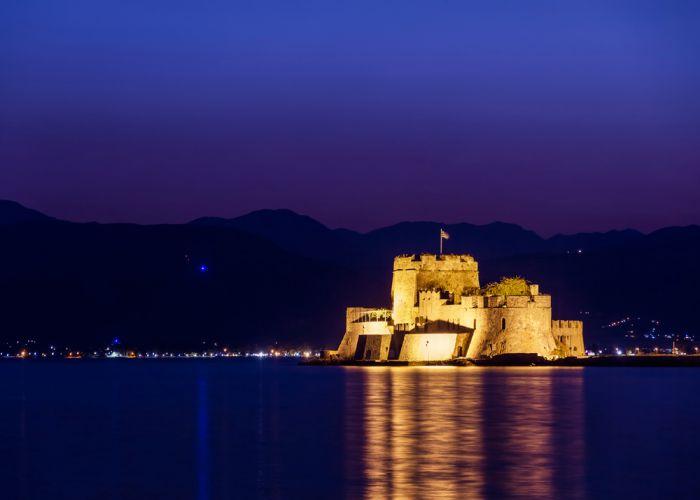
Recognizing its strategic significance, the Venetians decided to fortify the islet of St. Theodoroi by the time they seized the city of Nafplio. Situated at the mouth of the port, the islet stands as a guardian, ensuring the security and accessibility of Nafplio's port.
A huge chain anchored between the Acronafplia fortress and Bourtzi (Castello Dello Soglio) was often deployed to block the entrance of the port in the case of a siege.
The Ottomans used the islet likewise, but after the foundation of the New Greek State, this was a prison and the seat of the state executioner (guillotine).
Floating in the middle of the port, Bourtzi came to be one of the most iconic sceneries of the city. From the 1960s up until the 1970s, the castle served as a luxury hotel, but nowadays, it is a museum offering a rare window to the visitor of the city's medieval past.
Sail across the magical coast of Nafplio
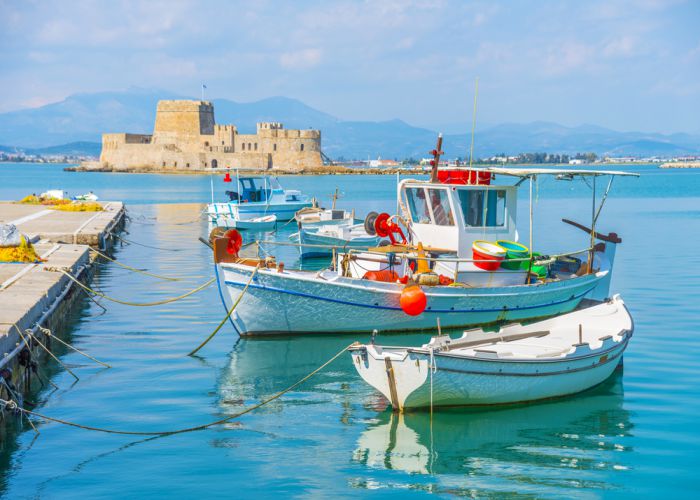 Picturesque fishing boats with Bourtzi in the background - credits: alexandros petrakis/Shutterstock.com
Picturesque fishing boats with Bourtzi in the background - credits: alexandros petrakis/Shutterstock.com
Being a seaside city, Nafplio is an ideal location for sailing tours that will elevate your trip to the next level and transform it into a luxurious experience full of glamor and opulent comfort.
Join us on a private Nafplio sailing adventure to see Nafplio's stunning coastline and feel royal. Enjoy the excellent romantic atmosphere that the city is known for, and swim on beautiful beaches you'd never seen before.
Those more adventurous travelers have the opportunity to take part in exciting water activities such as snorkeling. Of course, in true Greek style, these lavish experiences would be incomplete without food, so be prepared to savor a scrumptious meal on board!
Explore Greek history in Nafplio and its Archaeological Museum
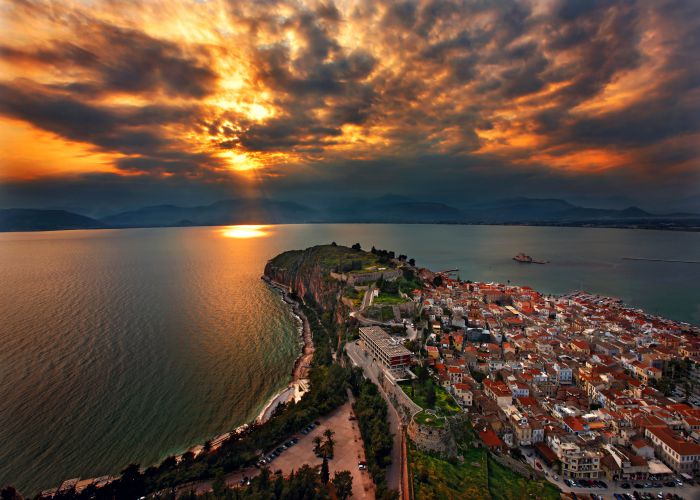 Nafplion - credits: Heracles_Kritikos/Shutterstock.com
Nafplion - credits: Heracles_Kritikos/Shutterstock.com
Many notable museums are available throughout the region, providing an excellent insight into the local culture and history while being hosted in important historic buildings.
Our favorite one, the Archaeological Museum of Nafplio, displays important artifacts during the prehistoric and Mycenae. It was once the site of the first Military School of Greek origin.
It is located at the west of Syntagma Square with an open arched entrance. Originally built as the Armeria (Armoury) in 1713, a small plaque on its wall commemorates the name of general Sagredo, who decided the erection of the building.
Moreover, the Komboloi Museum demonstrates a large global collection of local worry beads that have become an integral part of folklore culture.
Last but not least, Nafplio's War Museum, an annex of the Athens War Museum, was founded in 1988 in the impressive Venetian building, and it is worth your time when you visit Nafplio.
Stroll the Arvanitia Promenade and marvel at Nafplio's Medieval Castles
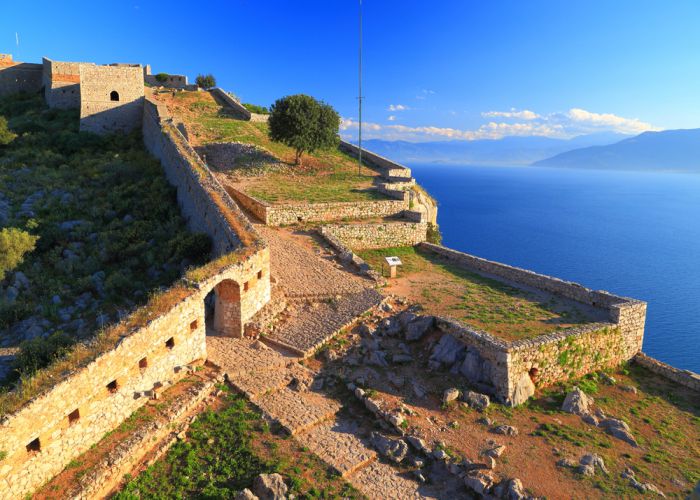 Palamidi Fortress - credits: Inu/Shutterstock.com
Palamidi Fortress - credits: Inu/Shutterstock.com
Among the most famous walks in the modern city of Nafplio is the one along the beach of Arvanitia. In fact, walking Arvanitia is a circular path that will take you to the port of the city.
It is a wonderful paved route that stretches across 1.5 km. The landscape is very beautiful as on one side, there are many prickly pears and Acronafplia, and on the other, the striking sea. It is truly everything you need for your afternoon walk to admire the sunset.
As it is only a breath away from the town center, the noise of the vibrant city disappears, and only the sound you will hear are the waves crashing into the shore.
Climb Palamidi Castle and discover its connection to the Greek war of independence
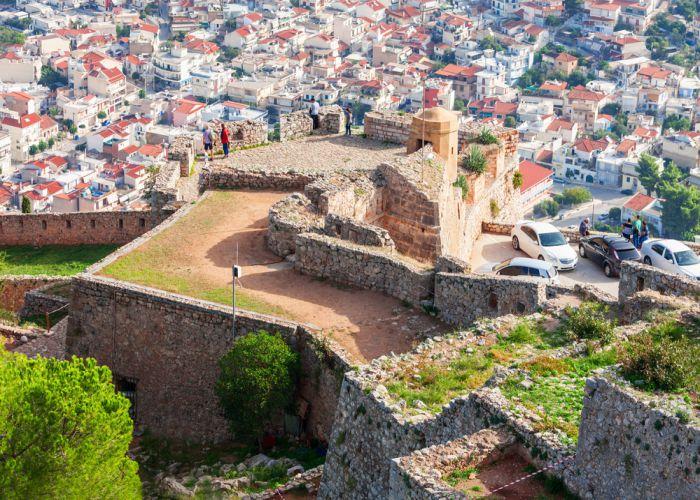
Part of an ambitious project undertaken by the Venetians, the hill of Palamidi is located in the south of Nafplio. According to ancient Greek mythology, Palamidis was the mythical son of Nauplius.
Archaeological investigation on the hill found ruins from different time periods, but the impressive fortress of the 18th century outshines everything else.
A typical baroque-in-style fortress, Palamidi Castle overlooks the Argolic Gulf, the city of Nafplio, and its open plains.
The Ottomans, after a long siege, succeeded in capturing the castle, only to be replaced by the Greeks in 1822. This location remained to be part of the military life of the city, operating as a State prison.
The famous hero of the Greek War of Independence, Theodoros Kolokotronis, was held captive in the bastion of Miltiades for a short period of time.
Today, the visitor has the opportunity to explore the fortress by following the over one-thousand-step snaky trail leading to the highest point of Palamidi Castle.
Cook traditional recipes
 Greek cooking class - credits: Shutterstock.com
Greek cooking class - credits: Shutterstock.com
Would it really be a blog post of ours if we didn't go on and on about Greek cuisine? Nadplio's gastronomy is as rich as anyone could expect.
Local dishes from the first capital of the modern Greek state include Bogana, which is lamb cooked with potatoes and usually served at weddings, and Gogas, which is hand-made local pasta found in Argolida that is traditionally cooked on Greek Halloween.
Take a day trip to the surrounding regions
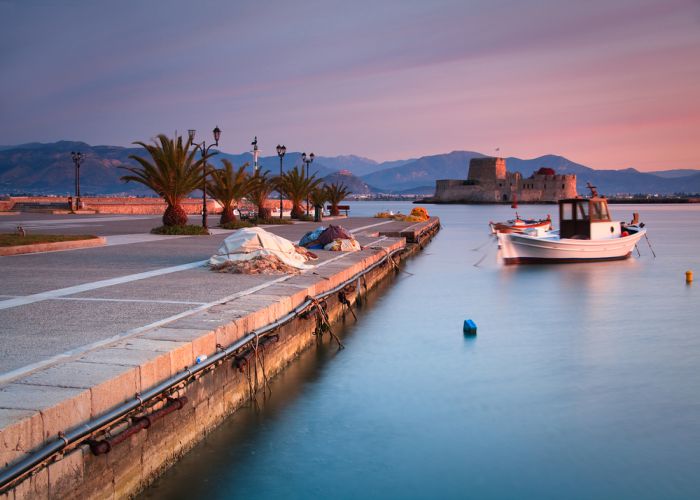 Nafplio pier view - credits: Milan Gonda/Shutterstock.com
Nafplio pier view - credits: Milan Gonda/Shutterstock.com
When visiting Nafplio, you won't want to miss the opportunity of seeing the stunning surroundings of this beautiful region. The Peloponnese has a wonderful landscape and is among the most beautiful regions of Greece, while it boasts many ancient sites dating back to classical antiquity.
Nafplio provides great scenery in Epidaurus and Nemea. Our Mycenae & Nafplio day trip will give you the chance to visit the old city of the royal Mycenae, see the prehistoric and Mycenaean eras unfold before your eyes, and even stop at the arresting Corinth Canal.
The more regions of Greece you get to see once you visit Nafplio, the better!
Swim in Nafplio's magnificent beaches
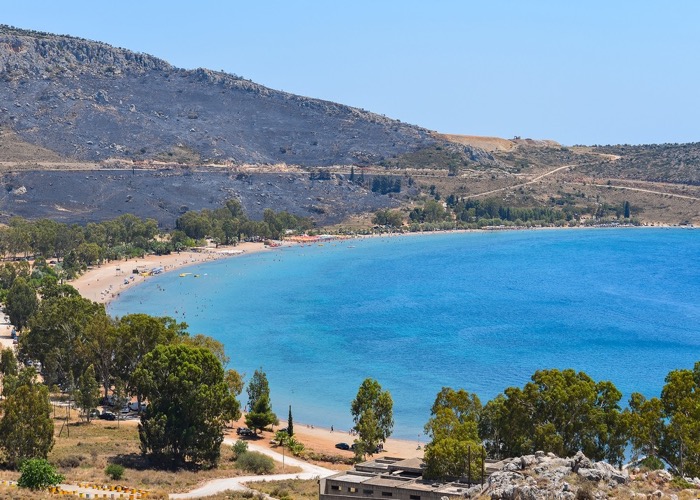 Karathonas Beach - credits: PitK/Shutterstock.com
Karathonas Beach - credits: PitK/Shutterstock.com
Sandy or pebbled, busy or isolated, Nafplio's beaches offer a refreshing break from your cultural vacation.
The most popular beaches of Nafplio are the organized beach of the small bay of Arvanitia and the long sandy beach of Karathonas.
Arvanitia Beach is not very long, at about 200 meters long, but it has crystal clear deep blue waters and has been awarded a Blue Flag. It has small pebbles, and it is also organized, with showers, sunbeds, toilets, and a beach bar.
Karathonas Beach, on the other hand, stretches in a bay south of the city, at about 3 km from Nafplio, and is offered for lovers of water sports.
Best things to see in Nafplio
The Land Gate
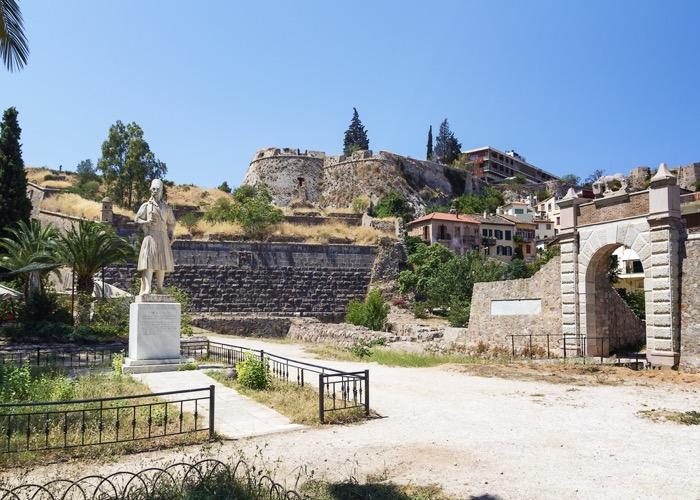
The Republic of Venice always had a special connection to the city of Nafplion, starting as early as Byzantine times. The importance the city held for Venice is evident everywhere in the city.
The impressive ruins the Venetian rule left of the different castles and fortifications made for the defense of the city prove how much the Venetian occupants cared for the security of this port.
Start your exploration from one of the remaining Venetian gates leading to the medieval city situated close to the main bus station of Nafplio. The gate is known as the Land Gate, and even though the walls are nowadays in ruins, the visitor can still imagine what the area used to be like.
Just before the gate, a deep trench was used to secure the inaccessibility of Nafplio in case of a siege. A small retractable bridge, open from dawn to dusk, allowed the inhabitants to access the old walled city.
Architecturally, the gate is an ashlar stone arch flanked by tower-like pilasters and crowned with the symbol of the Venetian Republic, a winged lion.
The crest of the Venetian Grimani family completes the decoration of the Gate. Originally built during the first Venetian occupation of the city, the form it has today, dates back to the beginning of the 18th century when a French engineer redesigned it.
Numerous warfares resulted in the partial demolition of the gate, but today, after an extended restoration program, the site stands as it was when first built.
Syntagma Square
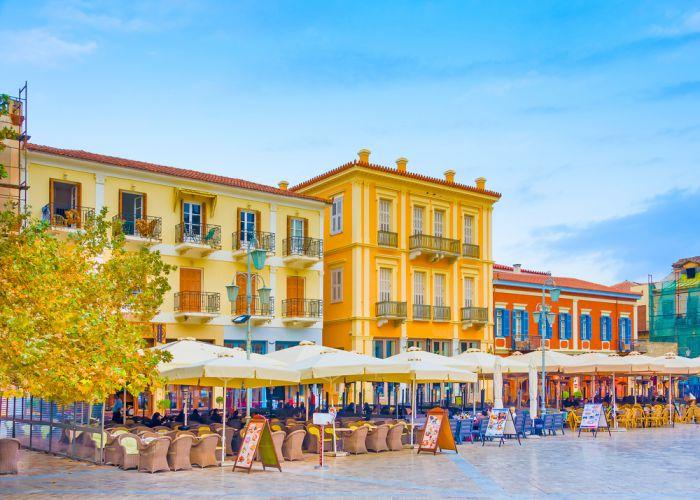
Just like the Syntagma Square in Athens, the central square of Nafplio commemorates the provision of a Constitution (1844), which limited the power of the King and controlled his authority.
This need for fundamental principles that dictate the smooth operation of the state was vividly expressed during the reign of King Otto, which reluctantly satisfied the demand of the protesters in Athens.
Despite its name, the main square of Nafplio is much older than the one in Athens. Initially formed during the Second Venetian Occupation (1686-1715), it was named Piazza di Armi (Square of the Arms). After the Ottoman occupation, the square was renamed 'the Square of the Planetree' due to a huge tree existing in the middle of it.
After the liberation of Nafplio and the establishment of the New Greek State, it was renamed 'Ludwig's square,' honoring the Bavarian king, father of King Otto of Greece. Standing in the middle of Syntagma Square, you have the chance to see some important buildings all around it.
At the center of the square, there is a black cube standing on a small pedestal that used to support a sundial. After the liberation of Nafplio, the square came to be the center of the government buildings of the modern Greek State during the time that Nafplio was the first capital of Greece.
The old Parliament building
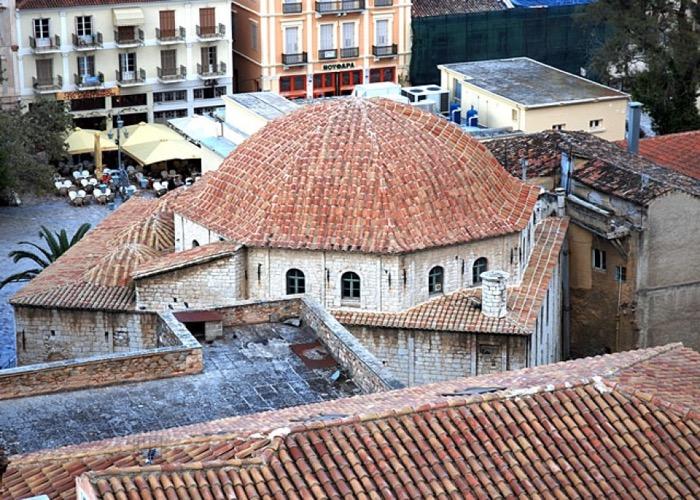
Right next to the Archaeological Museum of Nafplion, lies the building of the old Parliament. Originally built as a mosque, the old Parliament has a fascinating story. After the conquest of the city by the Ottomans, two Venetian brothers visited the city with the goal of discovering a treasure that their father had hidden during the siege.
Following a map, they located the treasure at the serai of the local Ottoman official (Aga). After coming to an understanding, the brothers decided to share the treasure with the Aga. In the meantime, the Ottoman Aga changed his mind and murdered both brothers to keep the treasure for himself.
Out of guilt, he spent some of the treasure to erect a mosque in an effort to soothe his conscience. From 1825 to 1826, the mosque was converted into the Parliament of Greece, but during the coming years, it served as a school, a court, and a prison.
Today, the building operates as a museum, the Municipal Gallery, with many events being held there.
Don't forget to look out for the Turkish fountains that adorn the older parts of the city!
Trianon
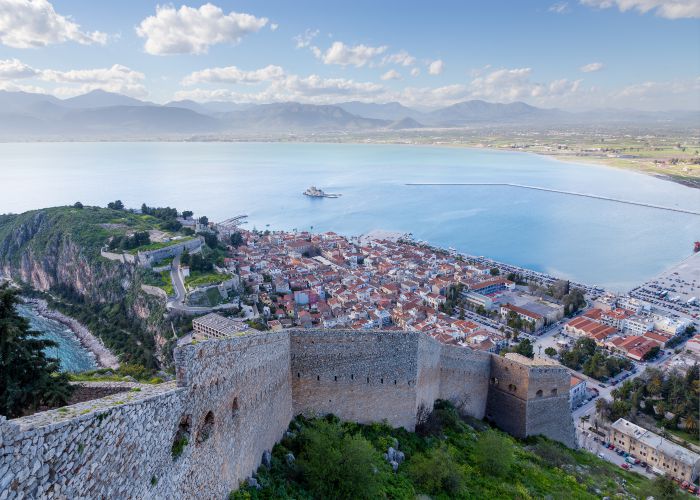 Peloponnese view - credits: lefpap/Depositphotos.com
Peloponnese view - credits: lefpap/Depositphotos.com
At the east end of Syntagma Sq., the visitor can see the oldest mosque of Nafplio standing there since the first Ottoman occupation of the city (ca. 1540-1686). It is a fine example of Ottoman architecture, and it has always had a central role in the everyday life of Nafplians.
After the reconquest of the city by the Venetians, the mosque was quickly converted into a Catholic church dedicated to Sant' Antonio di Padova with the expenses of the Doge Francesco Morosini.
During the coming years, it was re-installed as a mosque, but after the liberation of Nafplio from the Ottomans, it was used as a school. In 1915, it was remodeled to host a movie theater that was named 'Trianon,' the name that survives until today.
It is one of the smallest theaters in Nafplio, and if you have the chance, you definitely have to visit it while staying in the city.
The Sleeping Lion

A work of the German sculptor Christian Siegel, the first professor of Sculpture at the Polytechnic School of Athens, the sleeping lion of Nafplio follows the idea of the famous lion of Lucerne.
Commissioned by the father of King Otto of Greece, Ludwig I, it stands as a memorial to the Bavarian soldiers that succumbed to typhoid fever between 1833-4.
Situated in the neighborhood of Pronoia, it is directly carved on the natural rock, having a relaxed pose that emits power and tranquility at the same time.
After its completion, the locals named the lion Aggourhon because they attributed the death of the Bavarians to the excessive consumption of squirting cucumbers (Ecballium).
The church of Agios Spyridon
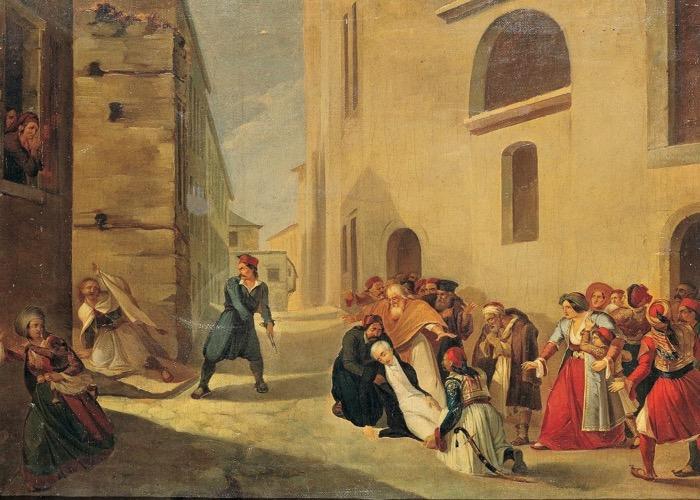
Located just one street before Syntagma Sq. at the center of the old town of Nafplio, the church of Agios Spyridon was built in the early 18th century by the Orthodox-Christian Greeks of the city. This church is known to every Greek because of an incident that sealed the fate of the New Greek State.
On the 27th of September 1831, the first appointed governor of Greece, Count Ioannis Kapodistrias, went to the church according to Greek customs to participate in Sunday's Mass.
When he exited the church, two political opponents of his murdered him just outside of the door with a stab in the abdomen and a shot to the back of his head. The crowd shocked at first, chased down the killers, lynching publically one of them and arresting the second one, that was executed for treason.
The death of Ioannis Kapodistrias (ironically at the steps of the patron saint of his birthplace, Corfu) put an end to the reforming program of the new, poor Greek state and dictated the introduction of foreign rules to the political scene of Greece.
Final Thoughts
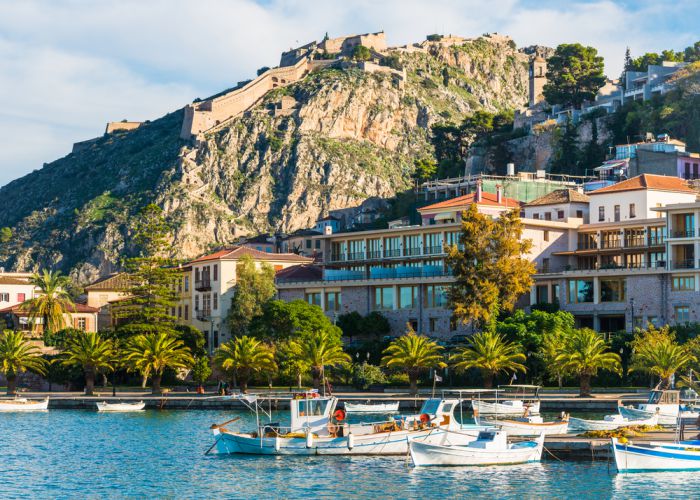 Nafplio - credits: Olga Kot Photo/Shutterstock.com
Nafplio - credits: Olga Kot Photo/Shutterstock.com
Nafplio is a city full of surprises and colors, monuments, and sites that you definitely should not miss. It is not just one of the most romantic cities in Greece but one of the most versatile as well.
Grab the chance and choose to engage in an insightful walking tour around the medieval town of Nafplio, plan your own trip to the city, or check out one of our Greece tours.





